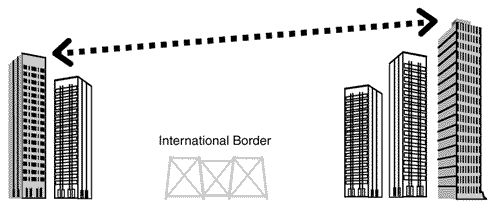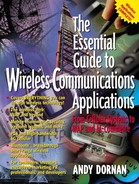Point-to-Point Microwave
Point-to-point microwave links are rare in the local loop because operators would require a separate base station unit for each customer. They provide higher capacities than multipoint systems, so are occasionally used to connect customers who would otherwise need fiber, but their main application is for private networks.
The classic example of a private point-to-point network is between skyscrapers in a city. If a company has two offices with a clear line of sight between them, it can save on call costs and leased line charges by installing microwave transceivers on each. This type of setup, illustrated in Figure 11.5, is called a wireless bridge. Typical systems have a range of up to about 20 km, so the offices could be in different states or even different countries. For example, some U.S. companies avoid expensive calls to and from Mexico by setting up a wireless bridge with one node in San Diego and the other in Tijuana.
Figure 11.5. Private point-to-point network (wireless bridge)

These systems can operate in both licensed and unlicensed bands. The most important are listed in Table 11.3
Licensed
Most microwave radio systems operate at frequencies between 18 and 38 GHz, where relatively large slices of bandwidth are available. They generally offer throughput of up to 155 Mbps, the same as LMDS. The advantages are that this capacity is two-way, it is dedicated to a single user rather than shared by an entire cell, and the range is increased by focusing the beam on a specific recipient.
Spectrum between 18 and 38 GHz always requires a license, though some vendors and user groups are pushing for this requirement to be removed; because point-to-point links confine their beams to very narrow area, there is little risk of interference. Fortunately, many governments have adopted rather liberal licensing policies, so in some countries it is little more than a formality.
Different parts of the spectrum are available for point-to-point wireless in different parts of the world. North America and Europe have agreed on four bands: 18, 23, 28, and 38 MHz. Europe has an additional band at 26 MHz, which cannot be used in the U.S. Their characteristics are very similar, and most equipment vendors sell transceivers for all of them; some can even be adapted, depending on which part of the world they are in.
The 28 GHz band is the same as that used for LMDS, meaning that licenses to use it have already been allocated. This may make it seem rather pointless, but some LMDS operators do find it useful. They can use point-to-point links for customers who require higher capacity than LMDs can offer, and also to link together their base stations.
Unlicensed
Point-to-point links can also be set up in unlicensed parts of the spectrum, although their performance will not be as good as their licensed counterparts. One option is the familiar ISM band, using IEEE 802.11 or similar equipment. It offers the same 11 Mbps capacity as in multipoint links, but this is dedicated to one user instead of shared over a cell.
For higher capacity links, the FCC actually has a special band dedicated to unlicensed point-to-point microwave. It occupies spectrum in the 5 GHz region and is known as U-NII (Unlicensed National Information Infrastructure). Using proprietary systems, vendors such as Proxim and Western Multiplex sell equipment that can send and receive at up to 100 Mbps in this band.
The disadvantage of the U-NII band is that it has only been granted by the U.S., not internationally. Some other countries may decide to adopt it, but Europe will not—it has already granted the same spectrum to the HiperLan wireless LAN standard. ETSI is trying to develop a version of HiperLan that can be used for local loop and building-to-building applications, but this isn't ready yet. Known as HiperAccess, it will offer two-way links at 20 Mbps.
| Band Name | Actual Frequencies | Used in | Max. Capacity | Licensed? |
|---|---|---|---|---|
| ISM | 2.4–2.483 GHz | Both | 11 Mbps | No |
| U-NII | 5.15–5.35 GHz 5.725–5.825 GHz | U.S. | 100 Mbps | No |
| 18 GHz | 17.7–19.7 GHz | Both | 155 Mbps | Yes |
| 23 GHz | 21.2–23.6 GHz | Both | 155 Mbps | Yes |
| 26 GHz | 24.5–26.5 GHz | Europe | 155 Mbps | Yes |
| 28 GHz | See Figure 11.4 | Both | 155 Mbps | Yes |
| 38 GHz | 37–39.5 GHz | Europe | 155 Mbps | Yes |
| 38 GHz | 37–38.4 GHz 38.6–40 GHz | U.S. | 155 Mbps | Yes |
Network Architecture
Although point-to-point radio is not usually thought of as ideal for WLL, some operators are using it. Instead of trying to connect every customer to their own central site, these companies connect each customer to another, a process known as daisychaining
The customers can't actually access each other's data or communicate directly (unless they want to); the intention is simply to extend the range of the system. Despite the limit of about 20 km, a customer could be much further away than this, using multiple hops to reach the operator. These extra hops make the system less reliable, as they introduce extra points of failure, so extra redundant links are sometimes added. For example, the operator Advanced Radio Telecom is building several 38 GHz networks around the U.S., with customers connected in a series of interlocking rings.
normal: Rings or Stars?In general, networks of all types can be arranged in three different ways, known as topologies. Real networks are usually a mixture, but the "ideal" cases serve to illustrate the point. The three topologies are shown in Figure 11.6.
|
Figure 11.6. Network topologies

